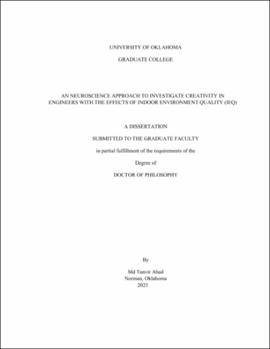| dc.contributor.advisor | Zahed, Siddique | |
| dc.contributor.author | Ahad, Md Tanvir | |
| dc.date.accessioned | 2023-04-27T17:38:23Z | |
| dc.date.available | 2023-04-27T17:38:23Z | |
| dc.date.issued | 2023-05-12 | |
| dc.identifier.uri | https://hdl.handle.net/11244/337486 | |
| dc.description.abstract | Investigations of creativity have been an intriguing topic for a long time, but assessing creativity is extremely complex. Creativity is a cornerstone of engineering disciplines, so understanding creativity and how to enhance creative abilities through engineering education has received substantial attention. Fields outside of engineering are no stranger to neuro-investigations of creativity and although some neuro-response studies have been conducted to understand creativity in engineering, these studies need to map the engineering design and concept generation processes better. Using neuroimaging techniques alongside engineering design and concept generation processes is necessary for understanding how to improve creativity studies in engineering. Recently, a growing number of studies have revealed that some types of indoor environmental stimuli can enhance human creativity. Further, for generating creative ideas temporal dynamics of cognitive processes are critical. However, how the temporal dynamics of creativity are influenced by the indoor environment remains unclear. This research found that each stage of the temporal dynamics of creativity may be differently correlated with neural function. Further, indoor environmental factors may have various, and sometimes contrasting, effects on the temporal dynamics of creativity. Despite recent progress, there are significant gaps in understanding the effects of indoor environmental quality (IEQ), especially air quality and factors related to visual, thermal and acoustic comfort that are closely tied to performance on cognitive tasks. This is due to the lack of understanding of the effects of IEQ on human physiological and neural responses. Nonetheless, this is the first study to clarify the influence of indoor environmental settings on the temporal dynamics of creativity from the perspective of neuroscience. | en_US |
| dc.language | en_US | en_US |
| dc.rights | Attribution 4.0 International | * |
| dc.rights.uri | https://creativecommons.org/licenses/by/4.0/ | * |
| dc.subject | Neuroscience | en_US |
| dc.subject | Creativity | en_US |
| dc.subject | Indoor environment quality | en_US |
| dc.title | An neuroscience approach to investigate creativity in engineers with the effects of indoor environment quality (IEQ) | en_US |
| dc.contributor.committeeMember | Cai, Jie | |
| dc.contributor.committeeMember | Liu, Yingtao | |
| dc.contributor.committeeMember | Song, Li | |
| dc.contributor.committeeMember | Tang, Choon Yik | |
| dc.date.manuscript | 2023-04-27 | |
| dc.thesis.degree | Ph.D. | en_US |
| ou.group | Gallogly College of Engineering::School of Aerospace and Mechanical Engineering | en_US |
| shareok.orcid | https://orcid.org/0000-0001-7624-8668 | en_US |

